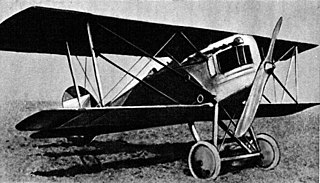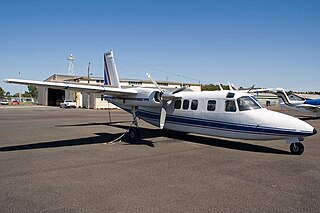
The Aero A.18 was a biplane fighter aircraft built in Czechoslovakia in the 1920s. It was a development of the Ae 02 and Ae 04 fighters Aero had designed during World War I, but also borrowed from the more recent A.11 reconnaissance-bomber design.
The Aero Boero 260AG is an Argentine agricultural aircraft that first flew in 1973. Despite the similarity in designation, it is completely different from and unrelated to the Aero Boero AB-260.

The Cessna 421 Golden Eagle is an American six or seven seat twin-engined light transport aircraft, developed in the 1960s by Cessna as a pressurized version of the earlier Cessna 411.

The Jodel D.11 is a French two-seat monoplane designed and developed by Société Avions Jodel in response to a French government request for a low-wing aircraft for use by the nation's many emerging flying clubs.

The Fauvel AV.36 was a single-seat tailless glider designed in France in the 1950s by Charles Fauvel. Although the "AV" in AV.36 stands for Aile Volante, it was not a true flying wing: it featured two large fins mounted on stubby tailbooms extending back from the wing's trailing edge, and accommodated the pilot within a stubby fuselage. The aircraft was designed to be quickly disassembled for road transport, with the nose detaching, and the fins able to fold back against the trailing edge of the wing. A refined version with a slightly longer wingspan, the AV.361 was introduced in 1960.

The Cassutt Special is a single-seat sport and racing aircraft designed in the United States in 1951 for Formula One air races. Plans are still available for homebuilding. Designed by ex-TWA captain Tom Cassutt, it is a mid-wing cantilever monoplane with fixed tailwheel undercarriage. The fuselage and tail are of fabric-covered steel tube construction, and the wings are built from plywood over wooden ribs. An updated taper-wing design was first flown in 1971 on Jim Wilson's "Plum Crazy".

The Croses Pouplume ("lousefeather") was an unusual ultralight aircraft developed in France in the 1960s. It was inspired by Henri Mignet's Pou-du-Ciel design with its distinctive tandem wing layout. Croses set out to develop a similar aircraft, to be powered by a single-cylinder motorcycle engine of around 6 kW (8 hp). Construction was wood with fabric covering. The resulting machine, designated the EC-1 weighed only 108 kg (238 lb) empty, and first flew in about 1960. Like the Pou-du-Ciel, the Pouplume dispensed with traditional ailerons and elevators, and pivoted the entire forward wing to provide pitch control.
The Duruble Edelweiss is a light utility aircraft designed in France in the early 1960s and marketed for homebuilding. It is a low-wing cantilever monoplane with retractable tricycle undercarriage and all-metal construction. The aircraft was designed for a load factor of 9. Two- and four-seat versions were designed. The aircraft's creator, Roland Duruble flew the first example, a two-seater designated RD-02 in 1962, and in 1970 began to market plans for a stretched version with a rear bench seat as the RD-03. Over the next 15 years, 56 sets of plans had been sold, and at least nine Edelweisses finished and flown. In the 1980s, Duruble marketed an updated version of his original two-seater as the RD-02A, and sold around seven sets of plans, with at least one aircraft flying by 1985.
The Falconar AMF-S14 Maranda is a two-seat, light aircraft first flown in Canada in 1961 and originally marketed for amateur construction by Falconar Avia.
The Fauvel AV.45 was an unorthodox motor glider produced in France in the 1960s and 1970s. Like other Charles Fauvel designs, it was a tailless aircraft, in this case inspired by the work that German firms had done on producing motorised versions of his AV.36 design. The prototype of the AV.45 was an extensively modified AV.36 powered by a Nelson H-59 two-stroke engine. AV.45s have been built with a number of other engines, however, including at least one aircraft powered by a small turbojet. Falconar marketed the plans in the 1970s.

The Flaglor Scooter is an unusual light aircraft designed in the United States in the mid-1960s and marketed for homebuilding.

The Great Lakes Sport Trainer is an American biplane trainer and aerobatic aircraft. It was originally produced in large numbers before the company building it went bankrupt in the Great Depression in 1933. Owing to its continuing popularity, however, it was eventually placed back into production in the 1970s and again in 2011 by WACO Classic Aircraft.

The Payne Knight Twister is a single-seat, single-engine aerobatic sport aircraft first flown by Vernon Payne Sr. in the United States in 1932 and marketed in plans form for homebuilding.

The Rockwell Commander 685 or Aero Commander 685 is a light-twin piston-engined aircraft with a pressurized cabin originally built by the Aero Commander company, a division of Rockwell International from 1965.

The W.A.R. FW-190 is a half-scale homebuilt replica of a Focke-Wulf Fw 190 fighter. In July 1973, War Aircraft Replicas International of Santa Paula, California began design of an approximately half-scale replica of the Fw 190, the first of a series of replicas of World War II aircraft using similar constructional techniques. The first prototype made its maiden flight on 21 August 1974.

The Baker MB-1 was a 45 degree delta winged experimental aircraft designed to maximize use of its 85 hp (63 kW) engine and experiment with delta-winged design.
The H-1 Doodle Bug is a single place homebuilt aircraft designed in the 1950s by Continental Airlines DC-6 pilot Lawrence K. Heuberger.
The Heuberger Sizzler is low-wing, tricycle gear, homebuilt aircraft that was designed by Continental Air Lines engineer Larry Heuberger.
The Kaminskas Jungster I aka Papoose RK-1 Jungmeister I is a single-seat homebuilt biplane.

The 1929 Curtiss Model 53 Condor, also known as the Curtiss Model 53 Condor 18 or the Curtiss CO Condor, was a civil passenger version of the Model 52 Condor bomber. A twin-engined biplane, it carried 18 passengers.













